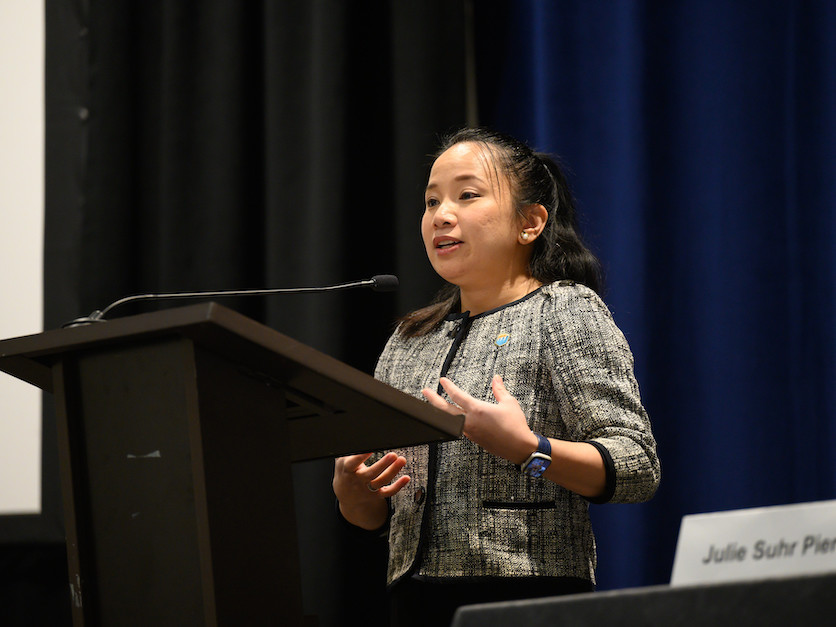The Bureau of Reclamation has inked 82 agreements promising to pay Colorado River water users with Inflation Reduction Act funding if they commit to cutting back on their water usage.
Michael Brain, the Interior Department's deputy commissioner for water and science, told a crowd of Western farmers and irrigation district employees at the Family Farm Alliance’s recent annual conference that the agency has signed 64 water conservation and implementation agreements with farmers and other water users in the four Upper Colorado River Basin states — Colorado, New Mexico, Utah and Wyoming.
Twenty-two similar agreements were signed by residents of the Lower Basin states, which include Arizona, California and Colorado. Overall, the agency will pay around $651 million for the first round of those agreements, according to agency data.
“These agreements will commit to more than 1.5 million acre-feet of system water through 2026, shoring up elevations in our reservoirs to support some of the critical decisions that lie ahead regarding our operations,” Brain said.
 Michael Brain, DOI
Michael Brain, DOIThe agreements are the result of $4 billion in Inflation Reduction Act funding that's designed to bolster water-saving efforts in the Colorado River Basin and other regions suffering from the impacts of long-term drought. The aim is to hold together water conservation efforts in the basin until the end of 2026, when current water guidelines will expire and state water officials will need to propose a new framework for distributing water cuts in times of drought.
The agency last year allocated $500 million worth of Inflation Reduction Act funds, Brain said. This money, however, was not necessarily all put toward these agreements; the agency also committed $250 million for habitat restoration to prevent unexposed sediment from the heavily polluted and rapidly deteriorating Salton Sea from being carried across the Imperial Valley by strong Southern California winds, one of the main priorities California water negotiators voiced in previous talks over cuts.
The agreements are part of two major Reclamation programs — one focused on paying water users in the Lower Basin, and the other focused on those in the Upper Basin.
The Lower Colorado Basin System Conservation and Efficiency Program pays water districts, farmers, municipalities and tribes in Arizona, California or Nevada that currently have delivery contracts with the Bureau of Reclamation or the Central Arizona Project for each acre-foot of water they relinquish.
Water users can follow two paths through the program. The first allows them to receive a set payment of $330 per acre-foot through a one-year agreement, $365 per acre-foot for a two-year agreement, and $400 per acre-foot for a three-year agreement.
It’s easy to be “in the know” about what’s happening in Washington, D.C. Sign up for a FREE month of Agri-Pulse news! Simply click here.
The second option allows for long-term agreements that also pay water users for each acre-foot they leave in Lake Mead, though under a different price framework. Payments under this option would be based on each water user’s proposal, the duration of the contract, and verification methodologies, according to the Congressional Research Service.
The largest recipient of funding under the program is the Metropolitan Water District of Southern California and the Palo Verde Irrigation District, which are receiving a total of $140 million to conserve 351,063 acre-feet of water through 2026, according to a list of recipients. That breaks down to $400 per acre-foot of water conserved.
The Gila River Indian Community will receive the second largest amount – $136 million to conserve 341,319 acre-feet through 2025.
The Imperial Irrigation District, the largest Lower Basin user of Colorado River water, received $77 million to conserve 100,000 acre-feet in 2023. That equates to $776 per acre-foot conserved.
The Upper Basin program also pays water users for each acre-foot of water they conserve. The System Conservation Pilot Program, operated by Reclamation and the Upper Colorado River Commission with up to $125 million in Inflation Reduction Act funding, offers a fixed price option of $150 for each acre-foot of water conserved, though applicants can suggest a different price in their proposals, according to a notice of request.
“We are taking the steps necessary to ensure that the basin not only survives, but the entire basin has the tools to manage our water resources sustainably into the future,” Reclamation Commissioner Camille Touton said in her remarks about the programs. “We will continue working with the basin to ensure the system conservation agreements through 2026 continue to be implemented.”
The agency is currently evaluating proposals for the second round of the Lower Basin program. They include 84 proposals from 37 different entities, according to Lower Colorado Basin Deputy Regional Director David Arend. In total, these proposals request over $5 billion in funding, more than what is available through the IRA, he said.
Recipients should be announced later this year, he said.
“We’re going through those, looking at them to see which ones make sense, see which ones we could support, [and] see which ones that have the most likelihood of success,” Arend said.
The Upper Colorado River Commission has said it would renew the Upper Basin program in 2024, according to its website.
The IRA funding factors heavily into a 2023 agreement among Arizona, California and Nevada to conserve at least 3 million acre-feet of Colorado River water through the end of 2026. Under the plan, Lower Basin water users would be federally compensated for up to 2.3 million acre-feet of their usage reductions.
Next month, the Bureau of Reclamation plans to finalize a draft supplemental environmental impact statement (SEIS) that considers the lower basin states' plan alongside operating guidelines for Glen Canyon and Hoover Dams, according to Wayne Pullan, Reclamation’s regional director for the Upper Colorado Basin Region. The agency said in a draft version of the document that the Lower Basin states’ agreement to preserve water levels in Lakes Powell and Mead would “more effectively protect both reservoirs through the end of 2026 than the status quo.”
 Camielle Touton, BOR
Camielle Touton, BORThe SEIS “will give us the tools that we need should things turn extremely dry in the years between now and the end of 2026,” Pullan said.
State water officials are crafting an entirely new framework to guide cuts in water allocations following the expiration of guidelines in 2026. Reclamation began the process with a 60-day scoping process last year, pooling together the comments it received into a Scoping Summary Report.
The fundamental question facing water users, as revealed by the comments, is: Should a new set of rules governing allocation reductions during times of drought follow the “first come, first served” model that has governed use of the river’s water for decades or be distributed evenly across multiple states and water users? Another debate central to the negotiations is whether certain crops, like alfalfa, should be deemed “beneficial uses” of water under the new standards, which guide how water recipients can use their allocations.
Three dam projects to bolster California water storage
California is expected to see a 1.7-million-acre-foot boost in storage capacity with the construction of three new water projects, Brain told conference attendees. These projects are partially funded by the Bipartisan Infrastructure Law, he said.
The projects include
- The B.F. Sisk Dam Raise and Reservoir Expansion project, which would create an additional 130,000 acre-feet of storage in San Luis Reservoir in Merced County. The project has received $95 million in federal contributions so far, including $35 million from the Bipartisan Infrastructure Law and $60 million from the Water Infrastructure Improvements for the Nation Act.
- The North-of-Delta offstream storage project, a collaborative effort to evaluate the feasibility of constructing the 1.3- to 1.8-billion-acre-foot Sites reservoir. In December, Reclamation certified the final environmental impact report for the proposed project, which would be located on the West side of the Sacramento Valley. Construction is scheduled to begin next year and expected to conclude in 2030, according to a press release. The project has received $60 million in Bipartisan Infrastructure Law funding, as well as $173.7 million from the Water Infrastructure Improvements for the Nation Act.
- The Los Vacqueros Reservoir Phase 2 expansion project, which would increase the existing Contra Costa County reservoir’s capacity from 160,000 to 275,000. The approximately $980 million project received around $92 million in Bipartisan Infrastructure Law funding, according to a Treasurer’s report from a Los Vacqueros Reservoir Joint Powers Authority meeting earlier this month.
John Watts, a former staffer for Dianne Feinstein who now serves as a senior counselor to Reclamation Commissioner Touton, told Family Farm Alliance members the agency is specifically focusing on funding non-federal dam projects to speed up the construction process.
Federal projects, he said, would require individual approval by Congress, which usually results in a lot of waiting. Typically, local water districts can approve feasibility studies more quickly than Reclamation, so it speeds up the process if they take the lead role and just have Reclamation sign off on these studies, he said.
Adam Nickels, the principal deputy regional director for the California-Great Basin Region, said the agency has been looking at the Sites Reservoir project in particular since 1942. The additional storage capacity all three projects will bring, he said, is a “phenomenal concept.”
“Almost 2 million acre-feet of storage in California — that’s phenomenal to me,” he said. “I think that’s going to help create sustainability for our agriculture industry, for the communities we serve.”
For more news, go to www.agri-pulse.com.


